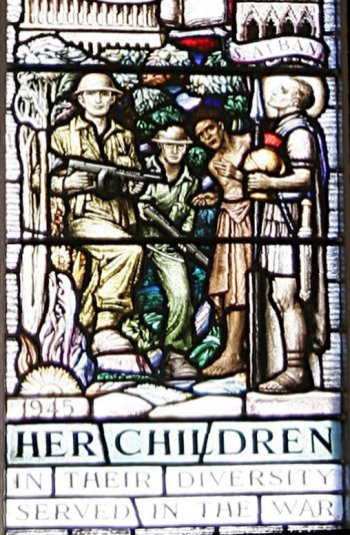
The bottom panel of the right light depicts the third of the three armed services, the army. This scene is set in New Guinea, with two armed soldiers and a native Papuan, who is indicating the way forward through the jungle. Setting the scene in New Guinea provides a link with the New Guinea Memorial window in the opposite transept of the church, and pays tribute to the sacrifices of Australian troops and the people of New Guinea on the Kokoda Track, where the advance of the Japanese forces on Port Moresby was vigorously opposed, and ultimately halted.
At the right of this scene a third soldier is depicted, in the dress of a Roman legionaire of the third century, with spear, short sword and plumed helmet. This is St Alban, whose story is told by Bede in his Ecclesiastical History of the English. Bede does not explicitly say that Alban was a Roman soldier, but tells us that he lived in the Roman city of Verulamium. Although he was a pagan, Alban gave shelter to a Christian priest who was fleeing from persecution. Influenced by the priest's prayer and teaching, Alban became a Christian.
When the priest's hiding place was discovered, Alban exchanged clothes with him, allowing the priest to escape. Alban was bound and taken before the judges, who were furious at the deception, and ordered that Alban should receive the punishment due to the priest. Despite a flogging, Alban re-affirmed his Christian faith and refused to sacrifice to the Roman gods. As a consequence, he was condemned to death, taken across the river to the top of a hill, and his head was cut off.
Legend tells that on the hill-top a spring of water miraculously appeared to give the martyr a drink. Moved by his witness, the first executioner refused to carry out the deed. The legend also tells that, after he had killed Alban, the replacement executioner's eyes fell out. St Alban is venerated as the first English martyr at the Cathedral and Abbey Church that bears his name.